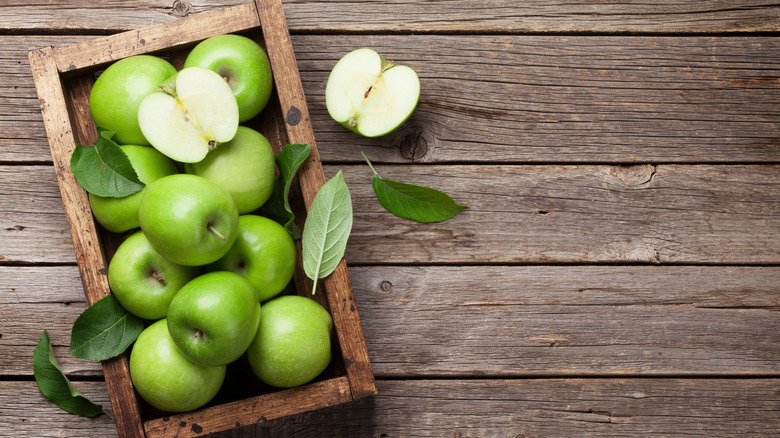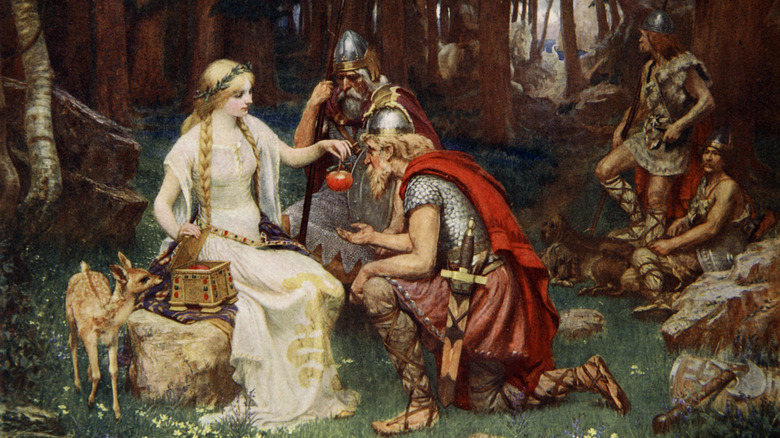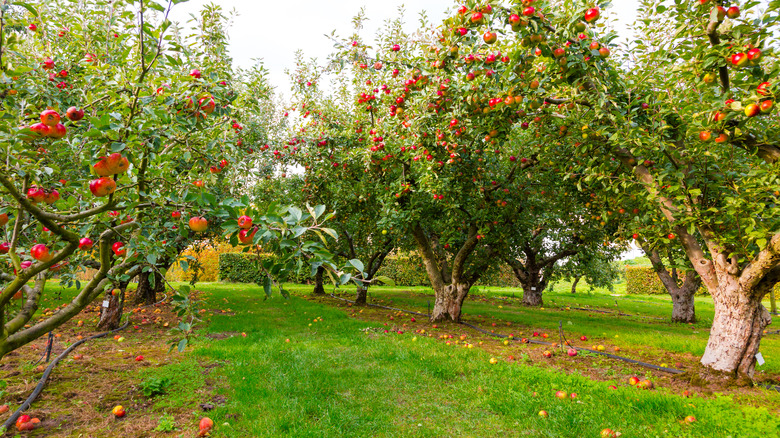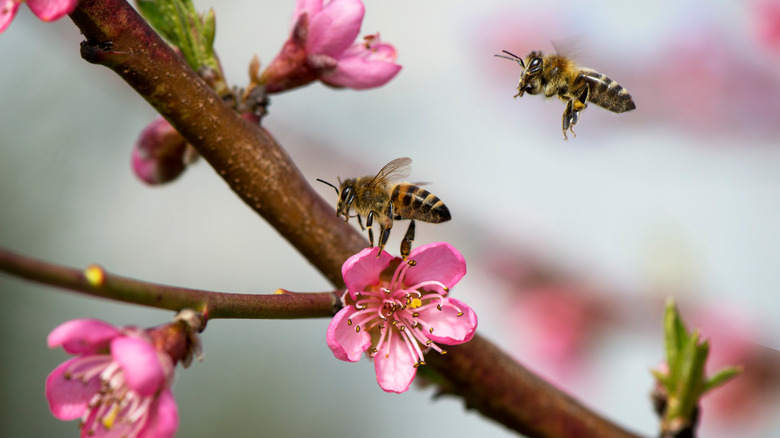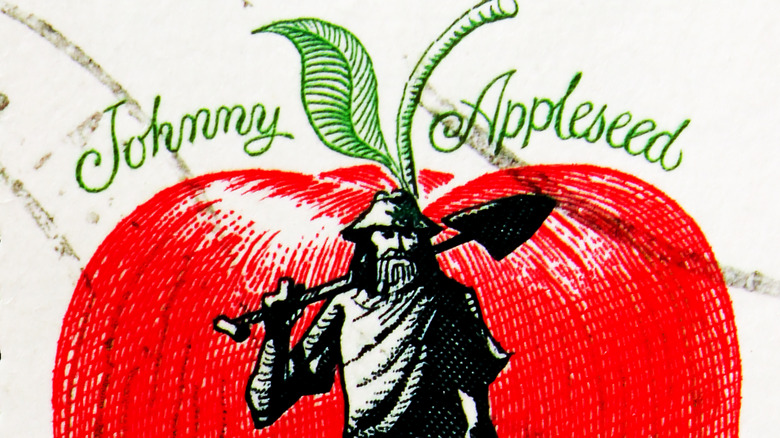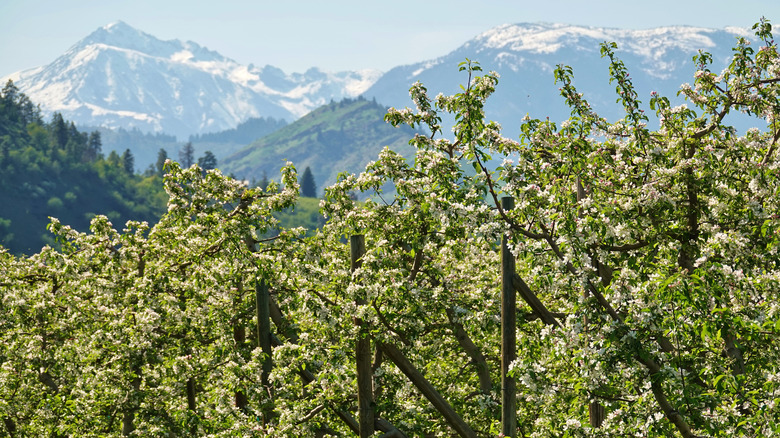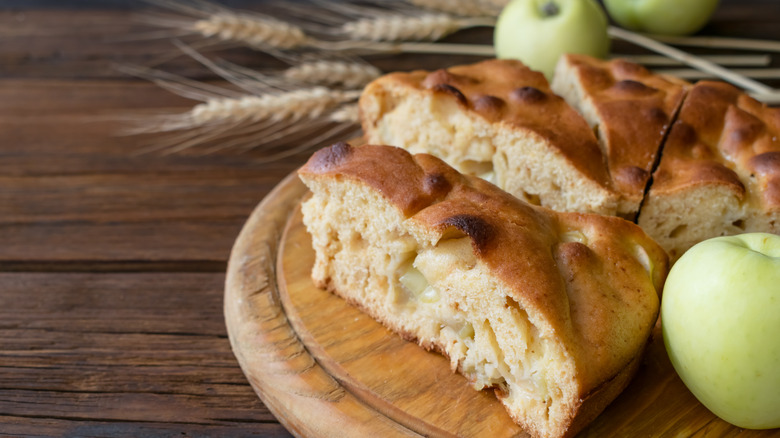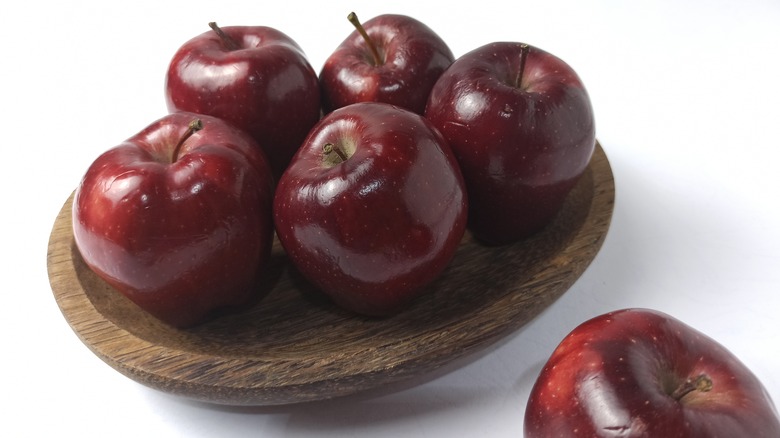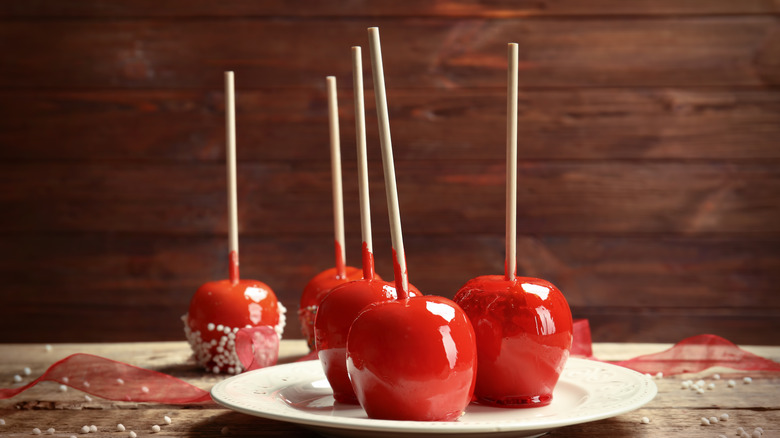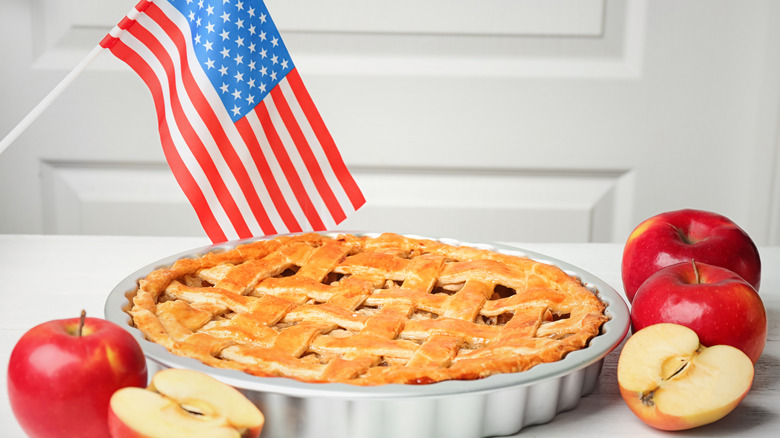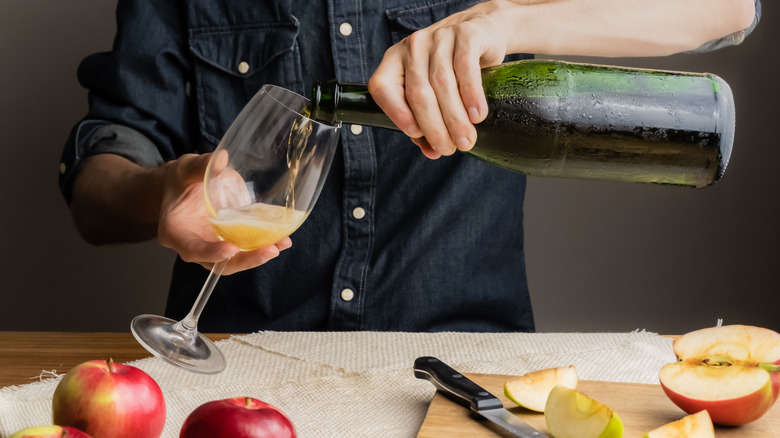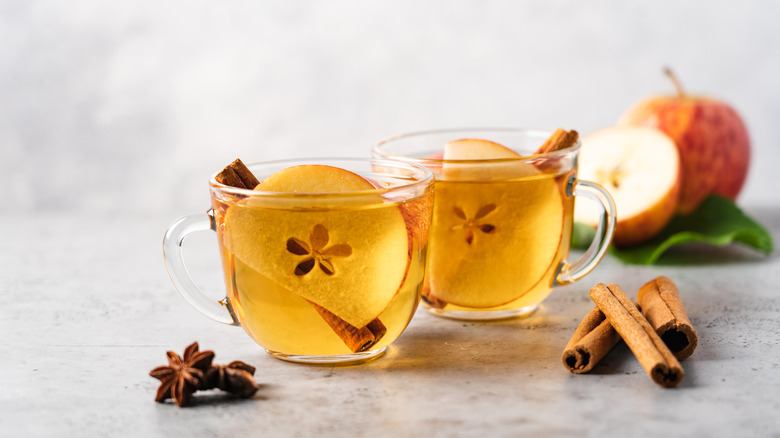The Culinary History Of America's Favorite Fruit: Apples
Botanically speaking, the Malus genus of trees hails from the Rosaceae family of rose bushes. They are popular with pollinators and aesthetically pleasing, particularly when covered in their signature white and pink springtime blossoms, but much more importantly they yield a fruit that is among the most widely beloved and cultivated across the globe: the apple (Malus Domestica).
Per Illinois University Extension, sour, inedible crab apples are the only kind of apples that are native to U.S. soil; the rest originated in Asia. The apple that spawned Malus Domestica and all of the delicious hybrids that have since followed, is known scientifically as Malus sieversii. It came from Kazakhstan and was identified by a Russian scientist named Nikolai Vavilov in 1929 (via BBC Travel), back when wild apple trees covered untamed forests and hybridized themselves without restriction. Historians believe the Silk Road trade, notes Smithsonian Magazine, is what brought Malus sieversii out of Kazakhstan and into the rest of the world.
To grow and care for an apple tree, you'll need a modest amount of space, some cold weather, and a ton of sunshine. However, if you'd like yours to bear fruit, you'll need one more thing: a second apple tree. That's because apple trees can only produce fruit if they receive pollen from another variety of apple trees, as explained by the University of Minnesota Extension.
Apples in legend and folklore
Ralph Waldo Emerson dubbed it America's fruit in the 1800s, but the apple earned its place in history well before the 19th century. Prehistoric apple remains have been unearthed in Europe, and ancient recordings suggest humans have been grafting fruit trees for propagation since the 1st century in China, Egypt, and Babylon, per What's Cooking America.
Greek mythology claims an apple caused the outbreak of the Trojan War. The jealous goddess Eris descended uninvited upon a banquet attended by all of the other gods and goddesses. She tossed an apple into the room with a note reading "to the fairest." The celebration went into a tailspin. A mortal was commanded to decide which goddess was the fairest, and it's safe to say not everyone was pleased with his decision (via Pressbooks).
The Swedish History Museum tells of Idun, the Norse goddess of eternal youth. Eating a golden apple from her collection was supposed to keep the gods young until the end of the world. Throughout Indigenous American Iroquois mythology, apple trees are revered as the Central Tree of Life. And yet, even though many Christians are enthralled by the story of Eve feasting on the forbidden fruit, nowhere in the Old Testament's Book of Genesis is there a mention of an apple, according to National Geographic.
Apples arrive in America
Malus Domestica finally made its way to American shores towards the end of the 1500s in the hands and pockets of French Jesuits, says North Carolina Historic Sites. Not long after that, apples hitched a ride across the ocean with the Pilgrims in the early 17th century, landing in what would become Massachusetts. The trees did so well in their new environment that, by the mid-1600s, it is believed that most of Maryland was covered in orchards.
The majority of trees grown in early colonial orchards produced fruits that were too tart to eat. Spitters, as they were called, were instead crushed into apple cider, which fermented quickly. No one appeared bothered by the alcoholic properties of the hard cider that was consumed by everyone, including children. Soon authorities declared that every able-bodied person was required to clear and improve land to keep it, reports Smithsonian Magazine, and planting an orchard was an easy way to do so.
Unfortunately, this solution to one problem did nothing to solve another; the colonists needed to hydrate their families and feed them. But just as domestic apple trees needed to be imported to the New World, so did the honey bee.
Enter the honey bee
Ultimately, colonists were able to become orchardists thanks to the pollinating powers of the honey bee; but at first, they did not exist here either. According to the Los Angeles County Beekeepers Association, honey bees needed to be brought across the ocean from Europe to the colonies to cross-pollinate trees, thus expanding the list of available varietals.
No one pollinates more apple trees than honey bees, and their major efforts allowed for sweeter varieties to develop and flourish. With that, the Pilgrims could begin making apples a part of American cuisine by first enjoying them as a snack right from the tree, and later cooking them into their meals and desserts. Apple pie grew in popularity so quickly that Amelia Simmons included a recipe for it in "American Cookery," the very first cookbook published in this country in 1796, notes the Historical Society of Pennsylvania.
Without the generous work of the honey bees, it's unlikely that America's fruit would prevail to the extent it has, and we probably would never have heard of our most admired apple pioneer, the man responsible for walking Malus Domestica west.
Johnny Appleseed walks the apple west
Peculiar is an appropriate adjective to describe John Chapman. Per the Library of Congress, everywhere he went, he went by foot, or canoe when necessary. He was regularly found barefoot wearing nothing but tattered rags. Confirmed accounts claim he really did carry a satchel of apple seeds slung over his shoulder and don a tin pot hat.
John Chapman was quirky but more than that, he was a shrewd entrepreneur. As the 1700s rolled into the early 1800s, private land-owning companies started offering pioneers 100 acres of land provided they planted dozens of apple and peach trees within three years. Chapman had no interest in purchasing land, but he saw a business plan in beating the settlers to their future plots and planting the trees for them.
Over time, Chapman truly came to embody his nickname of Johnny Appleseed. Per the Library of Congress, he is believed to have planted orchards across 100,000 square miles of wilderness. Because each apple tree is heterozygous, meaning when planted by seed its fruit maintains little resemblance to the original, the seeds Chapman planted would have bred countless varieties as trees grew and naturally hybridized themselves.
Most apple trees only live for 35 years at most and yet, there is one — known as the Johnny Appleseed Tree — that is confirmed to have been planted by the legend himself and is still standing on the Algeo Farm in Savannah, Ohio approximately 170 years later.
America's fruit reaches the Pacific Northwest
It took the honey bees over 200 years to migrate to the West Coast, notes the Los Angeles Beekeepers Association, and the same can be said for Malus Domestica. However, the first apple trees arrived not by travel across the frontier, but via direct shipment from London, circa 1826. According to History Link, the seeds that sprouted into the original Washington State apples were brought by Captain Aemilius Simpson who sailed to Fort Vancouver from Europe.
By the 1840s, the pioneers arrived with the saplings they'd propagated by grafting cut branches onto rootstock while walking the Oregon Trail. This proved the only way to get around the extreme heterozygous characteristics of the seeds and guarantee the apple type. The saplings thrived in the weather conditions and were perfect for apple trees.
Orchardists and engineers came together to harness snowmelt flowing down from the Cascades and into the valleys, notes History Link. Large-scale irrigation systems would ultimately launch the state of Washington into its now long-held position as the country's largest producer of apples.
According to the Brooklyn Botanic Garden, nearly 14,000 varieties of apples existed by this time across the country, but for the next few decades growers perfected only a handful of hybrids that grew well and were pleasing to the palette. Among the most popular hybrids towards the end of the 1800s were Winesap, Spitzenberg, Rome Beauty, and Jonathan (via History Link), some of which you can still sample today.
Apple cobbler & the apple brown Betty
As mentioned above, Jonathan apples are related to modern-day Jonagolds (Jonathans crossed with Golden Delicious), per Midwest Living. If you're in the mood to whip up an easy apple pie recipe, their sweet-tart flavor would make a great addition. Winesaps store well, and their spicy-tart bite pairs with wine and cheese, or cider. Rome Beauties are also still around on the market. They are late-season apples with a mild taste.
Perhaps you want to try your hand at the kinds of recipes Americans were baking back in the 1800s. For that, you could start with an apple cobbler. What differentiates the original cobbler from modern-day versions is the pastry dough covering on top.
If old English pudding is more your speed, consider making an apple brown Betty. What's Cooking America says a true 1860s-era Betty was made from buttered crumbs surrounding a layer of fruit. Other popular apple dishes of the time were the pandowdy, which called for molasses or brown sugar to sweeten it up, and bird's nest pudding, known for showcasing cored apples stuffed with sugar.
Red Delicious: Mass market appeal
According to the Brooklyn Botanic Garden, Stark Bro's nursery in Missouri became the first orchard to hone in on a single variety and catapult it to the level of mass-market success. Anyone who's heard of an apple has heard of the Red Delicious, and it was the Stark brothers who put it on the map. It was prized for its deep red hue and its tough skin that could survive transportation. Meanwhile, the heirlooms proved difficult to grow on trees that did not produce enough fruit to justify keeping them.
The meteoric rise of industrial-scale agriculture paralleled the incidence of prohibition, which found FBI agents cutting down the sour apple trees used for cider in an attempt to curb the consumption of alcohol, notes the Brooklyn Botanic Garden. The public had no choice but to embrace the sweeter snacking and baking varieties as many of the heirlooms died off into oblivion. It was during this period that the apple's primary function moved away from alcohol production, and its reputation morphed into that of health food that, when consumed in great quantity, could keep the doctor away.
After all these years, even though there are plenty of people who will tell you red delicious apples aren't actually delicious at all, the variety still reigns supreme as one of the most popular types of apples readily available in U.S. supermarkets.
The rise of candy apples
In 1908, Newark, New Jersey candy maker William W. Kolb was perfecting his recipe for a bright red candy with a spicy cinnamon kick. At the end of the trial, he slathered what was left onto apples, pierced them with lollipop sticks, and placed them in the window as a way to display his new candy, per International Independent Showmen's Museum.
Much to his surprise, customers believed he was selling the slathered apples, not just the candy, which was intended as a Christmastime treat. The confection caught on and first became a popular treat at circuses up and down the Jersey Shore, then a staple at county fairs and apple harvests, and were a common favor on Halloween.
While the country was downing candy apples at the fair, Fannie Merritt Farmer was busy attending the Boston Cooking School, where she would later serve as a director. Farmer's obituary in The New York Times states that she went on to change the world of cookbooks by being the first author to institute exact measurements into her recipes. Gone were the pinches of this and the splashes of that; Farmer used precise level measurements, which opened the door for anyone to learn how to cook.
One of Fannie Farmer's famous recipes for an apple crisp came out around 1924. If you attempt to replicate it, try Granny Smiths since they're considered the best type of apple for baking.
As American as apple pie
The country's fascination with apples took a cultural hold in the 1920s when advertisers used them as a symbol of patriotism. The connection became so pervasive that soldiers heading off to World War II often said they were going to fight for mom and apple pie. According to Grammarist, the combination of the two was meant to signify the most important core values of the American people. For a time, two idioms came together to create "as American as mom and apple pie," until a few decades later when advertising agencies struck again, by morphing it into "motherhood and apple pie."
If it seems arrogant of a country to claim its identity from the fruit and a dessert that both come from foreign lands, John Lehndorff of the American Apple Pie Council points out that the phrase acknowledges that they were brought here from elsewhere, just like all of us, and became American upon arrival (via CNN). Motherhood and apple pie is no longer the popular phrase it once was, however, it's interesting to note that Virginia still has a state holiday called Motherhood and Apple Pie Day included in its code of laws. On the other hand, as American as apple pie doesn't seem to be going anywhere.
Per Grub Street, modern-day pastry chefs continue to fixate on the fruit. There are so many amazing ways to cook with apples you could keep yourself busy with culinary experiments for months on end.
Hard apple cider brings back the heirlooms
Hard apple cider has been making a comeback for a little more than a decade, thanks to America's deep-seated fascination with craft brewing. That, combined with a torrent of customers on the hunt for gluten-free options, is putting hard cider on track to claim as much as 5% of the overall beer market (via Quartz).
How are cideries managing such output if all we grow here are sweet-tasting mass-market varieties? Turns out, a lack of bittersweet, sharp, and tart spitters is a major problem. Modern Farmer reports that cidermakers are constantly searching for a product that no longer exists. Some have the farmland to grow their own batches of Yarlington Mills, Porter's Perfection, Kingston Black, and other little-known heirloom varietals guaranteed to create the best-tasting cider. But the biggest problem these culinary artisans face for now is that they are expensive to grow without yielding much return. Eaters bring in profits, while spitters remain the less financially viable crop.
Still, in pockets of New England, Appalachia, and New York's Hudson Valley are growers set on bringing the heirlooms back to the market. With a little luck, the cider boom will continue and more of these oddly shaped, funky-tasting apples will be given a second chance.
Apple cider vinegar: Health tonic or fad?
When it comes to modern-day uses of apples, one cannot ignore the everlasting reputation of apple cider vinegar as a health tonic. Bart Maes explains that the concoction dates back at least to the teachings of Song Ci, an autopsy expert from 1200 B.C. who used it to prevent infections. Song Ci predates Hippocrates, another original teacher within the realm of medicine. He was touting the benefits of apple cider vinegar to Greeks some 2,500 years ago.
Apple cider vinegar was in use in the American colonies as early as the 1700s. Mixed with honey, lemon juice, ginger, and a little water, the tonic was used as a cure for pneumonia. The idea that apple cider vinegar could be used to remedy any ailments may have come from Dr. D.C. Jarvis of Vermont, who wrote a 1958 book called Folk Medicine: A Vermont Doctor's Guide to Good Health, in which he prescribed what he called honegar (half honey, half apple cider vinegar) to all patients no matter their illness.
Americans took the bait and many to this day continue to revere apple cider vinegar as a common cure-all and essential daily tonic. While it's true that vinegar can be medicinally beneficial, apple cider vinegar also has its fair share of myths that won't go away.
